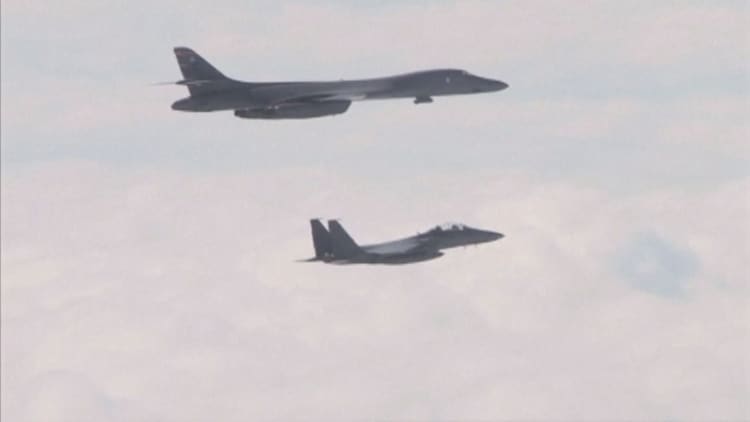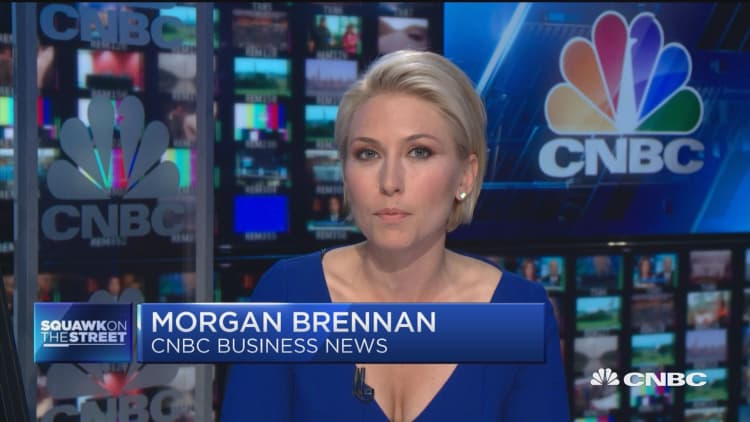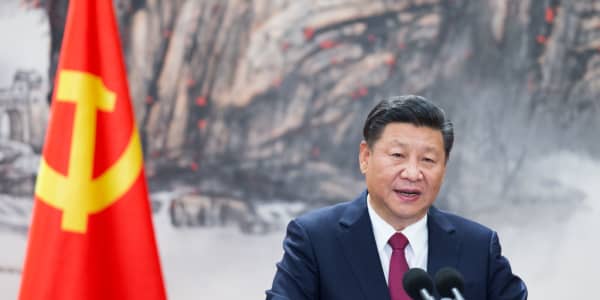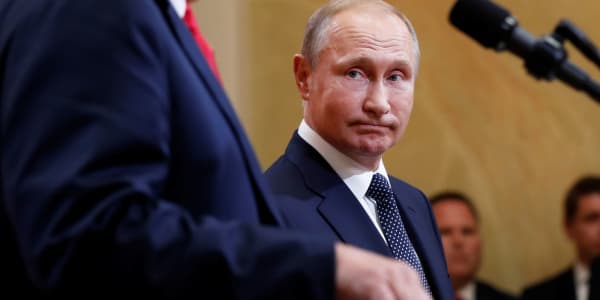
On Oct. 1, President Donald Trump once again took to Twitter to attack Kim Jong-un, saying that negotiating with the North Korean chairman is a waste of time. While social media mudslinging may not be the best way to deal with a hostile leader, there's at least one group who may not mind Trump's Twitter threats: defense industry investors.
Year-to-date, the S&P 500 Aerospace and Defense Industry subsector index is up 30 percent, compared to 12.9 percent for the . Since July 3, when North Korea fired its first intercontinental ballistic missile and Trump said in a tweet, "Does this guy have anything better to do with his life?" the index has climbed by 14.3 percent.
While most people likely don't want to go to war with North Korea, the increasingly heated rhetoric is helping many defense-industry stocks reach record highs.
"The more people that are nervous and afraid of what's going to happen in the world, the more it drives multiples higher," says David Chung, a research analyst at Janus Henderson Investors. "What we've seen in the last month with North Korea elevates that uncertainty."
As high as these stocks have climbed, some investment professionals, including Chung, still think there are opportunities to be had, though it will be increased defense-sector spending, not Twitter tirades, that drives the industry forward.
More military spending
Typically, it's the promise of increased military spending that boosts defense-sector stocks, says Karen Hiatt, a senior portfolio manager with Allianz Global Investors. While the sector has been outperforming the broader index for a few years now, prices jumped 6.8 percent in the week after Trump was elected, and they've climbed another 31 percent since then.

The increase is partly due to the Republican Party being seen as more military friendly, but Trump also said in February that he wanted to increase military spending by $54 billion. On Sept. 18 the Senate passed a $700 billion defense policy bill that exceeds Trump's original request. That's good news for investors, especially if those increases continue.
"There's a very high correlation between government spending around defense," says Hiatt.
However, it's often not about the actual increase that drives stocks higher, but the expectation for change, she says. It was in 2013, when defense spending bottomed, that these stocks really started to rise. This year's gains occurred because of the potential for increased spending — the subsector has risen only by 3.95 percent since the September announcement, though that's still better than the 1.9 percent for the S&P 500.
More from Global Investing Hot Spots:
Why the gusher in European stocks should continue
China's real estate investors are now on a $200B buying spree
For Dan Gruemmer, a portfolio manager with American Century Investments, those expectations — of increased spending and a more defense-friendly president and Congress —have not only helped push stocks, like Lockheed Martin and Harris Corp. higher, but they've created inflated valuations, too.
"We're in an environment right now where sentiment has been playing a larger role," he says. "And now they're almost priced to perfection."
Indeed, valuations are high, with many stocks having price-to-earnings ratios above 20. Both Lockheed Martin and Northrop Grumman — the latter purchased missiles and satellite maker ATK Orbital for $9.2 billion in September — are trading at 23 times forward PE, the highest their PEs have been in years, according to S&P Capital IQ. Gruemmer, who uses an intrinsic value metric in his company assessments, says that most defense companies are trading at least 10 percent higher than where they should be.
Improving fundamentals
While Chung agrees that valuations are elevated, most industrial stocks, which is the industry defense falls under, are trading at similar levels. He's still bullish, though, because over the last few years, these companies have become better operators.
Since the 2013 spending bottom, most have reduced costs and increased margins. Boeing, which is more known for its airplanes but does have a robust defense business, has cut $5 billion of costs over the last four years, while defense-segment operating margins have improved from 9.4 percent to 11.5 percent, says Chung. It's a similar story with other companies. All the sector needs now is to increase volume.
"They've done a lot of great things on the cost side, and production processes are in a much better place," says Chung. "Imagine what will happen if they get more volume through that."
The more people that are nervous and afraid of what's going to happen in the world, the more it drives [defense sector] multiples higher.David Chungresearch analyst, Janus Henderson Investors
Some companies also have certain divisions that have yet to see a growth increase. For instance, General Dynamics' combat systems business is "down meaningfully from its peak," says Chung, while Harris' radio communications division is down 50 percent from where it once was. He thinks both will rebound because of increasing order activity and higher budgeted amounts for those categories in the defense budget.
"Some stocks have certain programs that have been depressed over the last five years —incremental margins have come down 30 percent to 50 percent off of the peak," he says. "We think the profitability profile is quite attractive."
Hiatt likes the sector's fundamentals, too. Many of the companies have strong free cash flows and attractive yields, she says. Lockheed Martin, a company that she likes, has a 4.5 percent free cash flow yield, returns on capital of more than 20 percent and a 2.58 percent payout.
As well, because defense spending is determined in advance, earnings growth tends to be more predictable than in other industrial sectors, she says.
Another potential boost could come from international sales, which is a higher-margin business, as companies tend to charge other governments more to buy their equipment, says Gruemmer.
While America will always be the biggest buyer of military equipment, if the spectre of war increases in the Korean Peninsula, the Middle East and elsewhere, other countries could beef up their militaries as well. In September, President Trump announced his administration will permit U.S. allies Japan and South Korea to purchase a higher-than-expected amount of high-tech military equipment as the countries move to contain North Korea.
"Any time you see increased conflict in certain regions of the world, you often see increased international sales," he says. "And typically, companies realize higher profits with foreign customers."
What to buy
When it comes to buying into the sector, if you believe that the entire industry will continue to climb — and Chung does think the sector overall will continue to outperform — then you can purchase an exchange-traded fund, like the iShares U.S. Aerospace and Defense ETF (ITA), which is the largest defense-sector ETF, with $4.5 billion in net assets.
The fund, which is up nearly 29 percent this year, holds U.S. operations that manufacture commercial and military defense equipment — all of the large-cap defense stocks, like Boeing, United Technologies and Lockheed Martin, are in the portfolio. For mutual fund buyers, Fidelity Select Defense and Aerospace fund, which also holds the brand-name defense companies such as Boeing, Northrop, Raytheon and Rockwell Collins, among others, is a popular choice. It's rated four stars by Morningstar and is up 28 percent year-to-date.
Those who want to make a bet on an individual stock, though, should look for companies with attractive cash-flow yields, product-line diversity and wide geographic exposure, says Hiatt. Companies with low leverage and an ability to return money to shareholders through dividends or buybacks is important, too, adds Chung.
He likes General Dynamics, Harris and Northrop Grumman, partly because they have strong CEOs, good cash-flow yields and certain divisions, like radios for Harris and unmanned aircraft for Northrop, which should experience strong growth over the next several years.
No matter what you buy, though, the prospect of conflict and increasing military budgets worldwide should continue to push these stocks even higher.
"The world isn't getting safer, and there's a need for these companies' services," says Chung. "We feel comfortable about their competitive advantages, and their moats are wide. That's a good backdrop."
— By Bryan Borzykowski, special to CNBC.com




